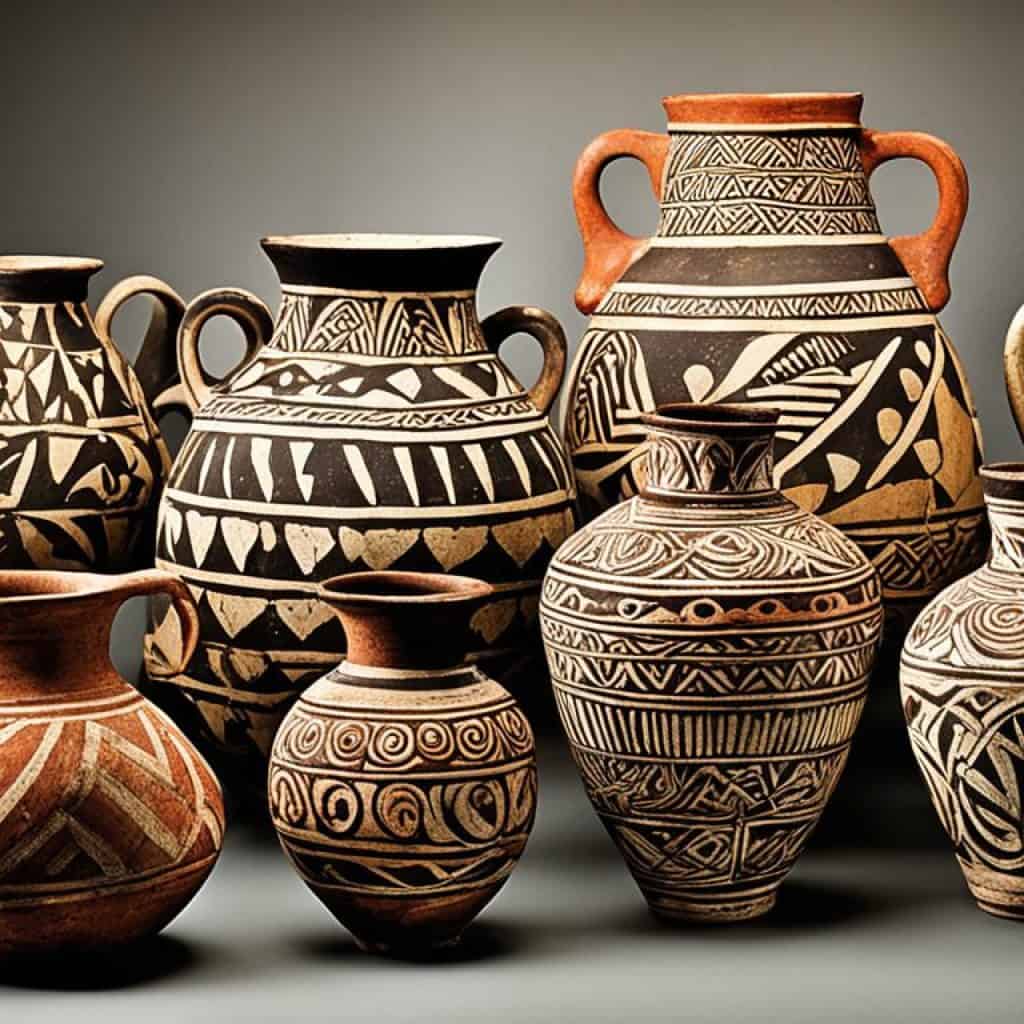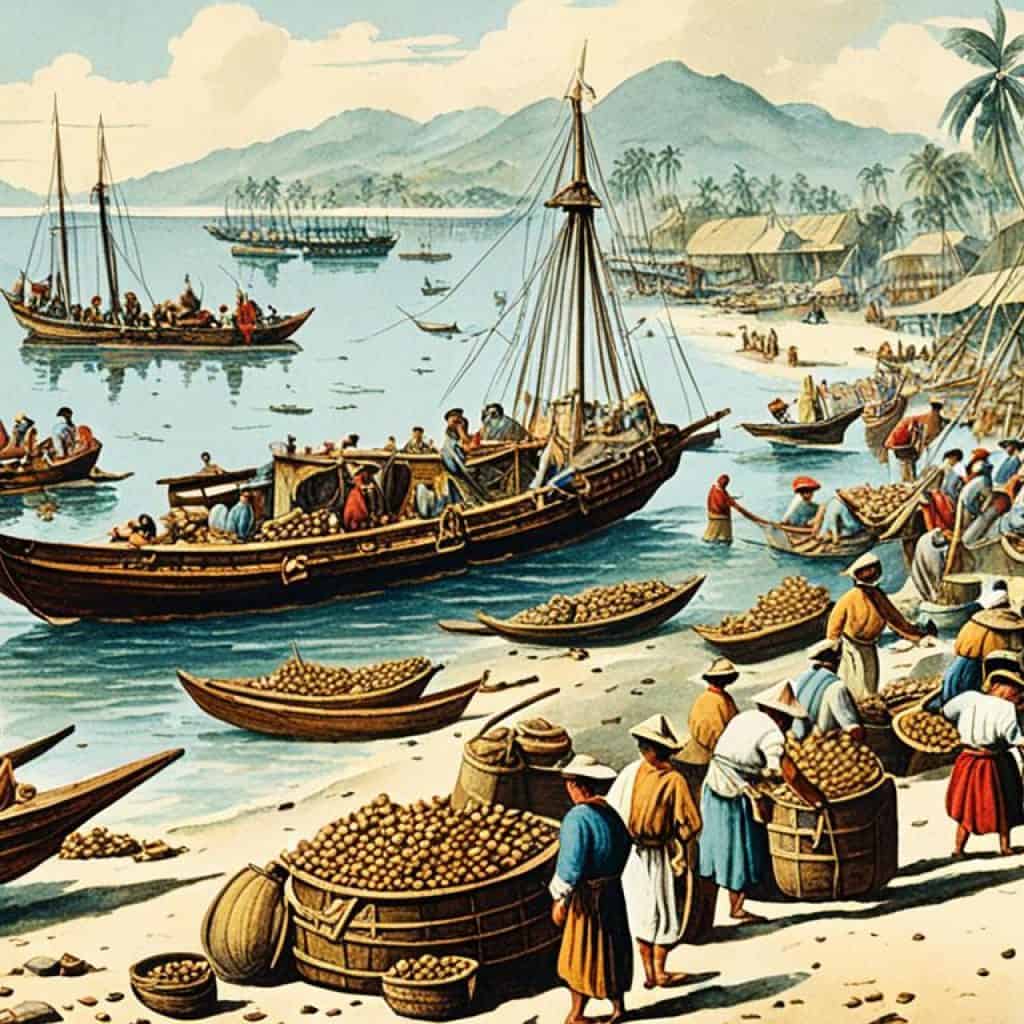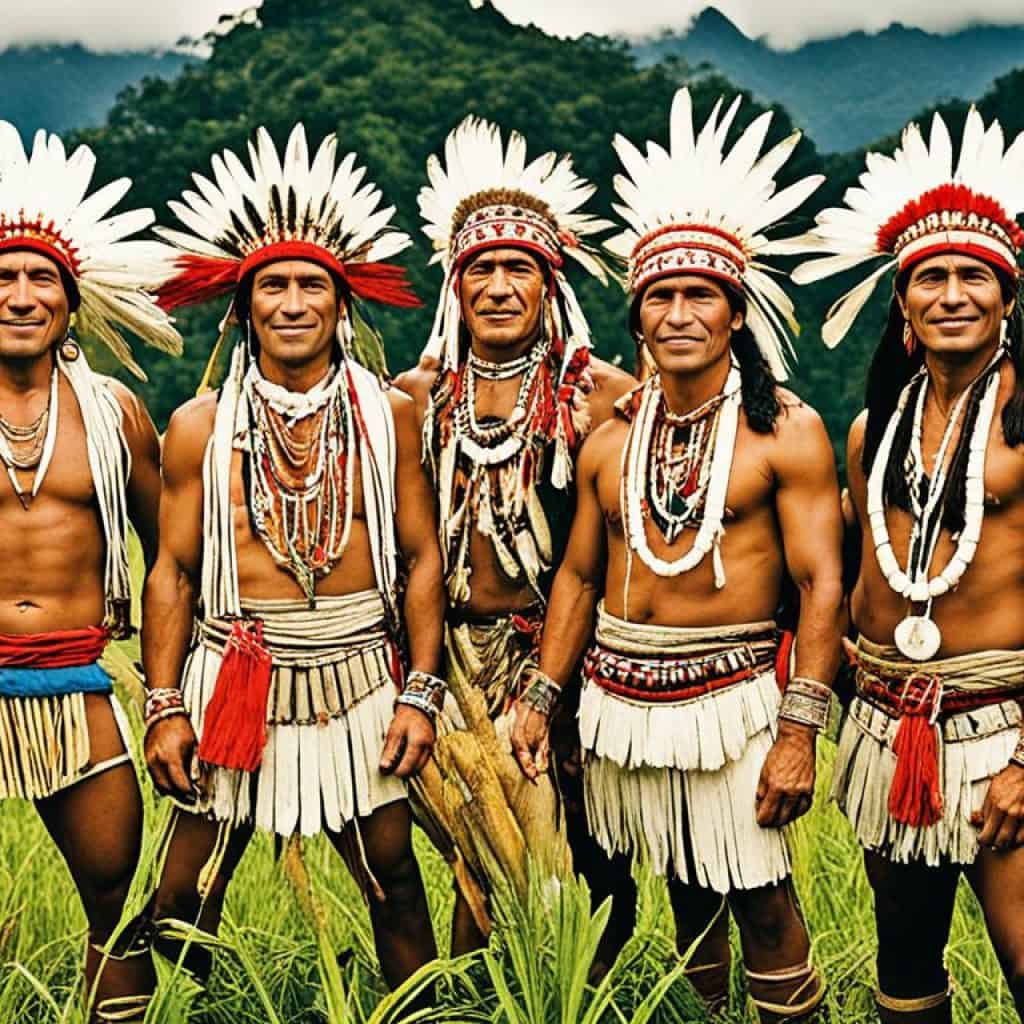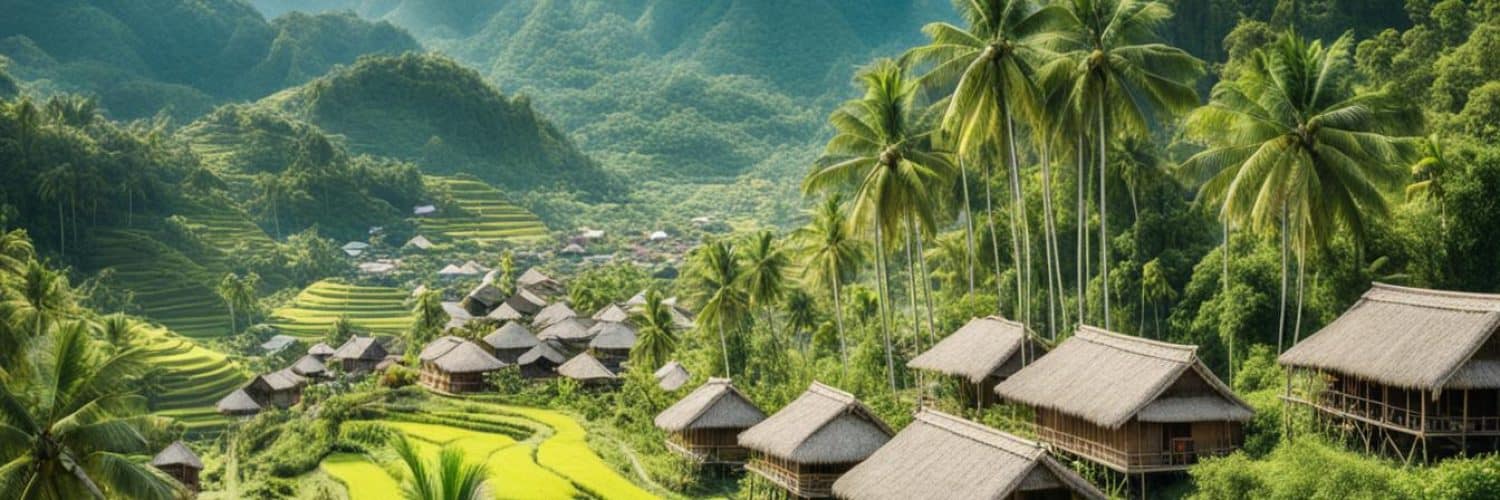Have you ever wondered about the hidden gems of Philippine history? Before the Spanish colonization, the Philippines had a rich and vibrant pre-colonial era that often goes overlooked. Indigenous tribes thrived, cultural achievements flourished, and historical events unfolded that shaped the colonial history of the Philippines. Join us as we delve into the fascinating world of the pre-colonial period in the Philippines and uncover its untold stories.
Key Takeaways:
- The Philippines had a vibrant pre-colonial era filled with diverse indigenous tribes.
- Spanish colonization had a profound impact on Philippine culture.
- The pre-colonial period witnessed significant historical events that shaped the colonial history of the Philippines.
- Indigenous cultural achievements in fields such as agriculture, arts and sciences, and trade influenced the development of Philippine society.
- Explore the rich tapestry of the pre-colonial era and uncover its lasting legacies in contemporary Philippines.
The Cultural Achievements of Pre-Colonial Philippines
The pre-colonial period in the Philippines was a time of remarkable cultural achievements. Indigenous tribes in the Philippines made significant advancements in various fields, including agriculture, technology, science, and the arts. These achievements not only demonstrate their ingenuity but also contribute to the rich and diverse cultural heritage of the Filipino people.
One of the notable cultural achievements during this period was in agriculture. Indigenous tribes developed sophisticated farming techniques and cultivated a variety of staple crops such as rice, millet, bananas, and root crops. Their expertise in agriculture is exemplified by the magnificent Banaue Rice Terraces, a UNESCO World Heritage Site, which showcases their advanced farming methods and sustainable practices.
Another area where pre-colonial Filipinos excelled was in the arts and sciences. They crafted intricate pottery, textiles, and ornaments, showcasing their artistic skills and creativity. Additionally, indigenous tribes were adept at traditional healing practices, utilizing medicinal plants and natural remedies to treat various ailments.
“The cultural achievements of the pre-colonial Philippines reflect the ingenuity and artistic expressions of the indigenous tribes. Their advancements in agriculture, arts, and sciences are a testament to their rich cultural heritage.”
Furthermore, indigenous tribes in the Philippines developed complex societal structures and belief systems that continue to be integral to many ethnic societies. These structures provided a framework for governance and social cohesion within their respective communities. The belief systems revolved around animism, with a deep reverence for nature, ancestral spirits, and deities like Bathala.
The cultural achievements of the pre-colonial Philippines not only highlight the creativity and intelligence of the indigenous tribes but also underscore their resilience and adaptability. These achievements serve as a source of inspiration and pride for present-day Filipinos, as they connect with their roots and preserve their cultural identity.
Historically Documented States/Polities in Pre-Colonial Philippines
The pre-colonial period in the Philippines witnessed the emergence of various historically documented states and polities. These states, located throughout the archipelago, exemplified the rich diversity of pre-colonial Philippine society.
Some of the historically documented states and polities in pre-colonial Philippines include:
| State/Polity | Location |
|---|---|
| Caboloan | North Luzon |
| Cainta | Rizal Province |
| Tondo | Manila |
| Namayan | Manila Bay area |
| Maynila | Manila |
| Ibalon | Bicol region |
| Ma-i | Pampanga |
| Pulilu | Pulilan, Bulacan |
| Sandao | Visayas region |
| Madja-as | Western Visayas |
| Dapitan | Zamboanga Peninsula |
| Cebu | Cebu Island |
| Butuan | Caraga region |
| Sanmalan | Palawan |
| Sultanate of Maguindanao | Mindanao |
| Sultanate of Buayan | Mindanao |
| Sultanates of Lanao | Mindanao |
| Sultanate of Sulu | Sulu Archipelago |
These states and polities were characterized by their own unique political systems, specific laws, and distinct cultural practices, contributing to the vibrant tapestry of pre-colonial Philippine society.
Notable Events and Artifacts of Pre-Colonial Philippines
The pre-colonial period in the Philippines was a time of significant historical events and the creation of remarkable cultural artifacts. These highlights from the past provide valuable insights into the rich and diverse heritage of the pre-colonial era.
Historical Events
- Maragtas
- Laguna Copperplate Inscription
Maragtas is a legendary account that details the settlement of the ten Malay datus in Panay Island. This event signifies the early establishment of organized communities in the archipelago.
The Laguna Copperplate Inscription, discovered in 1989, is a written document dating back to the 10th century. It provides evidence of a judicial pardon for a prince, making it one of the oldest known written documents in the Philippines and shedding light on the legal practices of the time.
Cultural Artifacts
- Butuan Ivory Seal
- Limestone Tombs of Kamhantik
- Kabayan Mummies
- Baybayin Script
- Butuan Silver Paleograph
The Butuan Ivory Seal is an ancient artifact discovered in Butuan City, Mindanao. It depicts a mythical creature and bears evidence of trading connections with other Southeast Asian countries.
The Limestone Tombs of Kamhantik in Southern Luzon are burial sites displaying the advanced burial practices and architectural skills of the ancient Filipinos.
The Kabayan Mummies, found in Benguet, are a collection of mummified remains that highlight the burial customs and beliefs of indigenous tribes in the Philippines.
The Baybayin Script, also known as Alibata, is an ancient writing system used by the early Filipinos. It is believed to have originated from the Brahmic scripts of India and testifies to the rich literary traditions of pre-colonial societies.
The Butuan Silver Paleograph is an engraved silver strip that provides evidence of extensive trade and diplomatic relations between the Philippines and other Asian countries during the pre-colonial period.

Agriculture in Pre-Colonial Philippines
Pre-colonial societies in the Philippines practiced various agricultural techniques that played a vital role in sustaining their livelihoods and ensuring food security. One of the prominent farming techniques was swidden agriculture, also known as shifting cultivation. This method involved clearing a patch of land through slash-and-burn techniques and then planting staple crops.
The cultivation of staple crops was crucial for the pre-colonial Filipinos. These crops included rice, millet, bananas, and root crops such as sweet potatoes and taro. They formed the foundation of their diet and provided sustenance for the entire community.
To witness the remarkable farming techniques of pre-colonial Filipinos, one need only look to the Banaue Rice Terraces. These terraces, recognized as a UNESCO World Heritage Site, exemplify the ingenuity and resourcefulness of the indigenous peoples. Not only do they showcase the advanced agricultural practices of pre-colonial communities, but they also reflect the deep cultural significance of rice as a staple crop in Philippine society.
| Pre-Colonial Staple Crops | Farming Techniques |
|---|---|
| Rice | Terrace farming, bunding (dike construction), irrigation systems |
| Millet | Planting in upland areas, drought tolerance |
| Bananas | Propagation through offsets, clonal multiplication |
| Root Crops | Swidden agriculture, tuber planting, crop rotation |
These advanced farming techniques enabled pre-colonial communities to harness the natural resources of the land and adapt to their environment. They exemplify the deep connection between the Filipino people and the land they cultivated, prioritizing sustainability and self-sufficiency.
Through their innovative agricultural practices and cultivation of staple crops, pre-colonial Filipinos demonstrated a profound understanding of their environment and the importance of agriculture in sustaining their communities. These agricultural traditions continue to influence Philippine farming practices and serve as a testament to the resilience and ingenuity of the indigenous peoples.
Martial Arts and Weaponry in Pre-Colonial Philippines
During the pre-colonial era in the Philippines, indigenous martial arts and traditional weaponry played a crucial role in the lives of the Filipino people. Martial arts were not only a means of self-defense but also served as a powerful expression of cultural identity and a way to strengthen social bonds within the community.
The indigenous martial arts of the pre-colonial Philippines were highly developed and encompassed a wide range of fighting systems and techniques. These martial arts were passed down through generations, with experienced warriors serving as instructors and mentors to train young individuals in the art of combat.
One of the most distinctive aspects of pre-colonial martial arts was the extensive use of traditional weaponry. The Filipino warriors mastered the art of wielding weapons such as the balaraw, kris, and kampilan. These weapons were not only practical tools for battle but also symbols of power and prestige within the community.
The balaraw, a double-edged sword typically measuring around 20 inches in length, was known for its versatility and effectiveness in close combat. The kris, characterized by its wavy blade and unique serpentine shape, was considered a sacred weapon believed to possess supernatural powers. The kampilan, on the other hand, was a long and heavy sword used by the Filipino warriors to strike powerful blows and penetrate the enemy’s defense.
“The pre-colonial Filipinos were skilled warriors, capable of utilizing their indigenous martial arts and traditional weaponry with remarkable precision and agility,” says Dr. Maria Santos, a renowned historian specializing in Philippine martial culture and heritage.
Pre-colonial martial arts and weaponry not only played a significant role in warfare but also had cultural and social implications. These practices promoted discipline, honor, and respect among warriors, instilling a sense of unity and pride within the community. Martial arts competitions and demonstrations were held as a way to showcase skills and foster camaraderie among tribes.
Today, the legacy of pre-colonial martial arts and weaponry lives on in modern Filipino martial arts, such as Arnis, Eskrima, and Kali. These arts continue to be practiced and taught, preserving the rich heritage and traditions of the indigenous warriors.
Notable Indigenous Martial Arts in Pre-Colonial Philippines
| Martial Art | Origin | Distinctive Features |
|---|---|---|
| Arnis | Visayan region | Emphasizes the use of sticks, blades, and empty hands |
| Eskrima | Tagalog region | Focuses on weapon-based fighting and intricate footwork |
| Kali | Mindanao region | Utilizes a comprehensive range of weapons and practical self-defense techniques |
The indigenous martial arts of pre-colonial Philippines continue to inspire and captivate martial artists around the world. Through these ancient arts, the legacy of the fierce and skilled pre-colonial warriors lives on, serving as a testament to the rich cultural heritage of the Filipino people.
Trade and Commerce in Pre-Colonial Philippines
Trade and commerce played a significant role in the pre-colonial Philippines, highlighting the region’s economic exchanges and maritime trade. The archipelago served as a crucial hub for trading activities, facilitating regular exchanges between China, the Philippines, and other Southeast Asian countries. Filipino merchants showcased their exceptional skills in navigation, seafaring, and economic exchanges.
The pre-colonial Filipinos engaged in trade with various cultures and economies in the region, creating dynamic networks of economic interactions. They exchanged a wide range of commodities, including precious metals, textiles, spices, ceramics, and agricultural products, harnessing the abundance of resources found in the Philippines. These trade networks fostered cultural exchange, technological transfer, and economic growth within the pre-colonial societies.
To navigate the vast waters of the Southeast Asian region, Filipino traders developed advanced seafaring techniques and navigational skills. They built sturdy and efficient watercraft, such as balangay boats, which allowed them to traverse long distances for trade expeditions. The maritime trade routes established during the pre-colonial period laid the groundwork for future trade networks and influenced the development of interconnected economies in the region.
During the pre-colonial era, the Philippines became a vibrant center of economic activity. The archipelago’s strategic location, rich resources, and skilled traders enabled the flourishing of maritime trade, benefiting both local communities and foreign traders.
Pre-Colonial Trade Routes
The pre-colonial Philippines had extensive trade routes that connected different parts of the archipelago with neighboring countries. These trade routes were vital pathways for economic exchanges and facilitated the flow of goods, ideas, and cultural influences.
Here are some of the prominent pre-colonial trade routes in the Philippines:
- The Manila-Acapulco Galleon Trade Route: This trade route connected Manila, in the Philippines, with Acapulco, in New Spain (now Mexico). It served as a vital link between Asia and the Americas, enabling the exchange of goods and ideas between the two continents.
- The South China Sea Trade Routes: These trade routes connected the Philippines with China, Vietnam, Malaysia, Indonesia, and other Southeast Asian countries. They facilitated the exchange of commodities such as silk, porcelain, spices, and precious metals.
- The Sulu Sea Trade Route: This trade route connected the Philippines with Borneo, Brunei, and other islands in the Indonesian archipelago. It was an important route for the trading of pearls, ceramics, textiles, and other valuable goods.
| Trade Route | Connected Regions | Main Commodities |
|---|---|---|
| Manila-Acapulco Galleon Trade Route | Philippines, New Spain (Mexico) | Asian spices, silk, porcelain, New World silver |
| South China Sea Trade Routes | Philippines, China, Vietnam, Malaysia, Indonesia, other Southeast Asian countries | Silk, porcelain, spices, precious metals |
| Sulu Sea Trade Route | Philippines, Borneo, Brunei, other Indonesian islands | Pearls, ceramics, textiles, valuable goods |
This table presents an overview of the different trade routes in the pre-colonial Philippines, along with the regions they connected and the main commodities traded.
Furthermore, the pre-colonial Filipinos developed sophisticated trading systems and marketplaces to facilitate economic exchanges. These marketplaces, known as “Tiongs” or “Pamilihan,” served as centers for barter and trade. They brought together merchants from various regions, fostering vibrant economic activity and cultural interactions.
Overall, trade and commerce played a crucial role in shaping the pre-colonial Philippines, contributing to its economic growth, cultural diversity, and connections with neighboring regions. The legacy of pre-colonial trade can still be seen today, as the Philippines continues to be an important player in the global trade landscape.

Religion and Belief Systems in Pre-Colonial Philippines
In the pre-colonial Philippines, the indigenous Filipinos practiced animism as their predominant religious belief system. Animism is the belief in the presence of spirits and supernatural entities in all natural elements, such as trees, rivers, mountains, and animals. The indigenous people worshipped and respected these spirits through various rituals and ceremonies.
Ancestral worship was an integral part of the pre-colonial Filipino belief system. They believed that their ancestors continued to exist in the spirit world and played an active role in their lives. Filipinos paid homage to their ancestors through rituals, offerings, and celebrations to seek guidance, protection, and prosperity.
Nature spirits also held immense significance in the pre-colonial Filipino belief system. These spirits were believed to inhabit the natural world and could influence human life positively or negatively. They were worshipped and appeased through rituals and offerings to maintain harmony with nature and ensure the well-being of the community.
In addition to ancestral worship and nature spirits, pre-colonial Filipinos worshipped deities such as Bathala—the supreme god in their pantheon. Bathala was seen as the creator of the universe, ruler of all spirits, and the giver of life. Devotion to Bathala was expressed through prayers, offerings, and rituals.
“The pre-colonial Filipinos had a deep reverence for the spiritual realm, which governed their daily lives and interactions with nature. Their religious practices were deeply rooted in their connection to the natural elements and their ancestors, paving the way for a vibrant and meaningful existence.”
Literature and Oral Traditions in Pre-Colonial Philippines
In the pre-colonial Philippines, literature took on a predominantly oral form, with epic poems, folk tales, and traditional narratives passed down through generations. These powerful literary pieces served as a means for indigenous peoples to preserve and transmit their customs, values, and ancestral heritage.
The oral literature of the pre-colonial Philippines showcased the creativity and storytelling skills of the indigenous tribes. Through epic poems, such as the “Biag ni Lam-ang” of the Ilocanos and the “Hinilawod” of the Panay Bukidnon, indigenous communities wove intricate tales of heroism, love, and adventure.
“Thy dawning is beautiful, O Bulan,// thou art not like unto the sun,// into the river I shall throw myself,// that I may die forever.”
Traditional narratives, such as the “Darangen” of the Maranaos and the “Ullalim” of the Kalingas, provided insights into the cultural values, societal norms, and spiritual beliefs of pre-colonial communities.
These oral traditions served as a way of imparting knowledge and moral lessons, strengthening social bonds, and instilling a sense of identity and pride within indigenous tribes.
Through the art of storytelling, the pre-colonial Filipinos ensured that their rich history and cultural heritage would be preserved and cherished for generations to come.
The Flores Manuscript
One of the notable literary works from the pre-colonial Philippines is the Flores Manuscript. This ancient document, written in Baybayin script, contains a collection of folk tales, legends, and religious texts from the Tagalog-speaking regions of Luzon.
The Flores Manuscript provides valuable insights into the spiritual beliefs, mythologies, and cultural practices of pre-colonial Tagalog communities. It is considered a treasure trove of traditional narratives that continue to captivate and inspire audiences today.
| Epic Poems | Traditional Narratives |
|---|---|
| “Biag ni Lam-ang” | “Darangen” |
| “Hinilawod” | “Ullalim” |
| “Ibalon” | “Hudhud” |
Social Structure and Political Systems in Pre-Colonial Philippines
Pre-colonial Filipino societies had distinct social structures and political systems that played a vital role in the governance and stability of the communities. These structures reflected the intricate web of relationships and responsibilities among the different members of society.
The social hierarchy in pre-colonial Philippines consisted of various classes, each with its own roles and privileges. At the top were the datus, the ruling class who held leadership positions and wielded significant power and authority. They were responsible for maintaining order, resolving disputes, and protecting their communities.
Below the datus were the maginoo, the nobles who inherited their social status and enjoyed privileges such as owning large tracts of land. The maginoo played crucial roles in politics, acting as advisers to the datus and participating in decision-making processes.
The maharlika, on the other hand, were the warrior class. They were skilled fighters who defended their communities and formed the backbone of the pre-colonial Philippine military. The maharlika held a respected position in society and were often granted land and other privileges in exchange for their service.
The timawa were freemen who owned their land and were considered as the middle class of pre-colonial society. They were skilled farmers and craftsmen who contributed to the economy and provided resources to higher-ranked individuals.
Lastly, the alipin were the dependent class, comprising both slaves and servants. The alipin had limited rights and were bound to their masters. They performed various tasks, including agricultural labor and household chores, in exchange for protection.
This social hierarchy in pre-colonial Philippines was crucial in maintaining order and harmony within the society. Each class had specific responsibilities and obligations, contributing to the overall well-being and governance of the indigenous communities.

“The social structure in pre-colonial Philippines was intricate and nuanced, reflecting the diverse cultural landscape of the indigenous tribes. It showcased the importance of hierarchy and responsibility within the society, ensuring the smooth functioning of political systems.”
Cultural Achievements and Innovations in Pre-Colonial Philippines
During the pre-colonial period, the Filipino people demonstrated impressive cultural innovations and advancements in various fields. Indigenous craftsmanship flourished, resulting in the production of exquisite textiles, pottery, and ornaments. Pre-colonial Filipinos were known for their exceptional skills and artistic abilities, honed through generations of craftsmanship.
The indigenous artisans developed culinary and healing arts that showcased their deep connection with nature and their sustainable way of life. Traditional dishes were created using locally sourced ingredients, while medicinal practices relied on the abundant resources available in the environment. These culinary and healing arts continue to be cherished and practiced by Filipino communities to this day.
Furthermore, the fine arts thrived in pre-colonial Philippines. Folk literature, in the form of epic poems and traditional narratives, captured the rich history, cultural values, and ancestral heritage of the Filipino people. Calligraphy, performing arts, and craft arts also played a significant role in preserving and expressing the beauty of pre-colonial Philippine culture.
“The craftsmanship of pre-colonial Filipinos was a testament to their creativity, attention to detail, and profound respect for their craft. Each artifact and artistic expression revealed the ingenuity and rich cultural heritage of the indigenous communities.”
The cultural achievements and innovations of pre-colonial Filipinos have had a lasting impact on the country’s history and continue to shape contemporary Philippine culture. These achievements are a source of pride for the Filipino people, and they serve as a reminder of the artistic talents and advancements of their ancestors.
Historical Legacies of Pre-Colonial Philippines
The pre-colonial period in the Philippines has had a profound and lasting impact on the country’s history and culture. The rich traditions and practices of this era continue to shape and influence contemporary Filipino society. The historical legacies of the pre-colonial era are a testament to the resilience, creativity, and rich heritage of the Filipino people.
One of the significant historical legacies of the pre-colonial Philippines is the preservation of indigenous languages, customs, and belief systems. Despite the influence of Spanish colonization, many Filipinos still maintain a strong connection to their pre-colonial roots. Traditional languages are spoken, and indigenous ceremonies and rituals are celebrated throughout the country.
“The pre-colonial era laid the foundation for our cultural identity as Filipinos. It is through understanding and appreciating our historical legacies that we can truly embrace our roots and contribute to the progress of our nation.” – Dr. Maria Garcia, Cultural Historian
Another notable legacy is the recognition and promotion of traditional arts and craftsmanship. From intricate weaving and pottery to vibrant traditional dances and music, the pre-colonial era’s artistic expressions continue to be cherished and preserved. Indigenous communities play a vital role in passing down these artistic traditions to future generations.
The pre-colonial period also left an enduring influence on the architecture and infrastructure of the Philippines. Structures such as the Banaue Rice Terraces and ancient settlements like the Kamhantik limestone tombs serve as reminders of the advanced engineering and construction skills of pre-colonial Filipinos.
Furthermore, the pre-colonial era’s emphasis on communalism and social cooperation still resonates in contemporary Filipino society. The concept of “bayanihan,” or community unity, continues to be a guiding principle in times of crisis and serves as a source of strength and resilience for the Filipino people.
Overall, the historical legacies of the pre-colonial Philippines symbolize the enduring spirit of the Filipino people and their ability to adapt, thrive, and preserve their rich cultural heritage. These legacies form an integral part of the contemporary Philippines, shaping its identity and providing a strong foundation for the future.
| Historical Legacies | Impact of Pre-Colonial Era |
|---|---|
| Preservation of indigenous languages, customs, and belief systems | Continued practice of traditional languages, ceremonies, and rituals |
| Promotion and preservation of traditional arts and craftsmanship | Recognition and celebration of pre-colonial artistic expressions |
| Influence on architecture and infrastructure | Remnants of advanced engineering and construction skills |
| Emphasis on communalism and social cooperation | Guiding principle of “bayanihan” and source of resilience |
Conclusion
The pre-colonial period in the Philippines was a time of immense cultural diversity, remarkable achievements, and the development of unique political and social systems. Indigenous tribes in the Philippines flourished, creating rich and vibrant societies with advanced agricultural techniques, indigenous martial arts, and thriving trade networks.
Artistic expressions, literature, and oral traditions showcased the creativity and storytelling skills of the Filipino people. The pre-colonial period also witnessed the rise of historically documented states and polities, each contributing to the complexity and diversity of the Philippine society.
Today, the legacies of the pre-colonial era continue to shape the contemporary Philippines. They serve as a reminder of the resilience, creativity, and cultural heritage of the Filipino people. From the agricultural practices that sustain communities to the traditional beliefs and values that are still respected, the pre-colonial era has left an indelible mark on the fabric of Philippine society, emphasizing the importance of preserving and celebrating the country’s rich pre-colonial heritage.


















Add comment